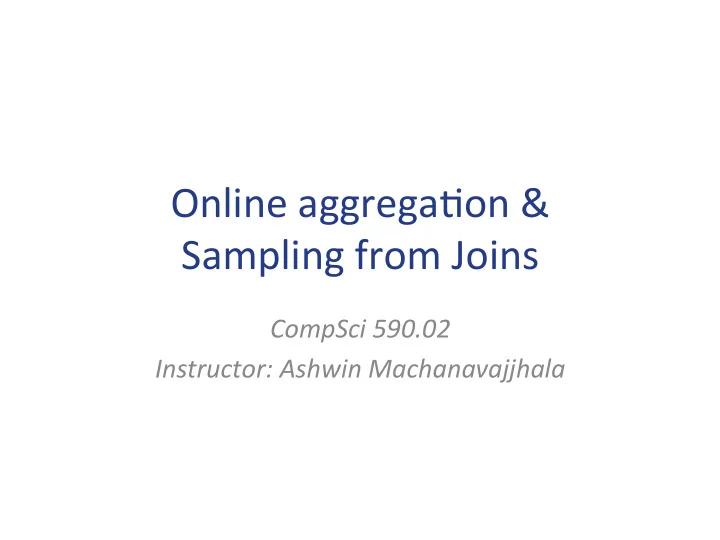

Online ¡aggrega*on ¡& ¡ ¡ Sampling ¡from ¡Joins ¡ CompSci ¡590.02 ¡ Instructor: ¡Ashwin ¡Machanavajjhala ¡ ¡
Outline ¡ • Online ¡Aggrega*on ¡ • Ripple ¡Joins ¡ • On ¡the ¡hardness ¡of ¡sampling ¡from ¡Joins ¡
Online ¡Aggrega*on ¡ • Most ¡systems ¡compute ¡aggregated ¡like ¡averages/counts/ etc. ¡exactly. ¡ ¡ • But ¡aggregates ¡only ¡provide ¡a ¡“summary-‑view” ¡of ¡the ¡ data. ¡ ¡ • Why ¡wait ¡for ¡an ¡aggregate ¡computa*on ¡on ¡the ¡en*re ¡ data? ¡ ¡
Online ¡Aggrega*on ¡
Examples ¡of ¡Queries ¡ • Select ¡Sum(Salary) ¡From ¡R ¡ ¡ DISTINCT ¡ • Select ¡Count(DISTINCT ¡hashtags) ¡from ¡T ¡ GroupBy ¡ • Select ¡Average(Grade) ¡from ¡STable ¡GroupBy ¡CourseID ¡ JOIN ¡ • Select ¡Sum(Grade*Difficulty) ¡from ¡STable, ¡Course ¡ ¡
Example ¡Scenarios ¡ • Compute ¡the ¡number ¡of ¡individuals ¡in ¡the ¡table ¡that ¡ sa*sfy ¡func*on ¡F, ¡where ¡F ¡is ¡a ¡computa*onally ¡intensive ¡ property. ¡ – Running ¡the ¡query ¡on ¡the ¡en*re ¡data ¡takes ¡O(nf), ¡where ¡f ¡is ¡the ¡ *me ¡for ¡checking ¡F ¡on ¡one ¡record. ¡ ¡ – We ¡can ¡get ¡an ¡approximate ¡answer ¡much ¡faster ¡… ¡
Example ¡Scenarios ¡ • Compute ¡the ¡sum ¡of ¡all ¡elements ¡in ¡a ¡database, ¡which ¡is ¡ par**oned ¡on ¡k ¡machines. ¡ ¡ – Compute ¡sum ¡on ¡each ¡machine ¡Si, ¡and ¡then ¡add ¡up ¡all ¡the ¡Si’s ¡ – Time ¡taken ¡to ¡compute ¡aggregate ¡= ¡max(*me ¡taken ¡by ¡one ¡ machine) ¡ ¡ – If ¡a ¡machine ¡fails ¡… ¡
Example ¡Scenarios ¡ • Find ¡the ¡number ¡of ¡people ¡in ¡database ¡D1 ¡also ¡appears ¡ in ¡database ¡D2 ¡ – Exact ¡answer ¡needs ¡checking ¡|D1|.|D2| ¡pairs ¡of ¡records. ¡ ¡ – Can ¡we ¡get ¡an ¡approximate ¡answer ¡faster? ¡ ¡ ¡
Aggrega*ons ¡on ¡a ¡single ¡table ¡ 1. Read ¡the ¡records ¡of ¡the ¡table ¡in ¡a ¡random ¡order ¡ 2. Maintain ¡a ¡ running ¡es?mate ¡ ¡of ¡the ¡required ¡aggregate ¡ 3. Compute ¡confidence ¡bounds ¡on ¡the ¡error ¡in ¡the ¡running ¡ es*mate. ¡ ¡
Random ¡access ¡ • Random ¡I/Os ¡are ¡expensive ¡ • Heap ¡Scans ¡ – Heaps ¡maintain ¡the ¡data ¡in ¡the ¡order ¡in ¡which ¡they ¡are ¡inserted ¡ – If ¡inser*on ¡order ¡is ¡not ¡correlated ¡with ¡values, ¡then ¡this ¡can ¡be ¡ used ¡instead ¡of ¡a ¡true ¡random ¡ordering ¡ • Index ¡Scans ¡ – If ¡index ¡is ¡on ¡an ¡aaribute ¡that ¡is ¡not ¡the ¡same ¡as ¡the ¡ aggregated ¡column ¡ • Sampling ¡from ¡indexes ¡ ¡ – From ¡previous ¡class ¡
Group-‑By ¡ • E.g., ¡Select ¡Avg(Salary) ¡from ¡R ¡GroupBy ¡Department ¡ • Standard ¡technique ¡ – Sort ¡the ¡rela*on ¡by ¡the ¡grouping ¡aaribute ¡ – Compute ¡the ¡within ¡group ¡aggregate ¡by ¡scanning ¡the ¡sorted ¡ output ¡ • Sor*ng ¡is ¡a ¡blocking ¡opera*on ¡ ¡ • Alterna*ve ¡: ¡Hashing ¡
Running ¡Es*mate ¡ • If ¡N ¡is ¡the ¡number ¡of ¡tuples ¡in ¡the ¡data ¡ • If ¡n ¡is ¡the ¡number ¡of ¡tuples ¡seen ¡… ¡ • SUM ¡: ¡N/n ¡(current ¡sum) ¡ • COUNT: ¡N/n ¡(current ¡count) ¡ • AVG ¡: ¡1/n ¡(current ¡sum) ¡
Confidence ¡bounds ¡ Assuming ¡the ¡input ¡tuples ¡are ¡randomly ¡chosen. ¡ If ¡Xi ¡is ¡the ¡random ¡variable ¡corresponding ¡to ¡the ¡i th ¡tuple, ¡ then ¡X1, ¡X2, ¡… ¡are ¡independent ¡random ¡variables. ¡ ¡ P{|Yn ¡-‑ ¡μ| ¡> ¡ε} ¡< ¡ ¡2 ¡exp{-‑2nε 2 ¡/ ¡(b-‑a) 2 } ¡ ¡ Where ¡ ¡ • Yn ¡is ¡the ¡running ¡es*mate ¡aner ¡seeing ¡n ¡elements ¡ • μ ¡is ¡the ¡actual ¡aggregate ¡ • [a,b]: ¡range ¡of ¡the ¡values ¡in ¡the ¡database ¡
Online ¡Aggrega*on ¡over ¡Joins ¡ • How ¡to ¡generate ¡a ¡random ¡ordering ¡of ¡pairs ¡of ¡tuples ¡ from ¡the ¡Join ¡of ¡a ¡rela*on? ¡ – Op*on ¡1: ¡Compute ¡the ¡join ¡and ¡then ¡read ¡the ¡output ¡of ¡the ¡ join ¡in ¡a ¡random ¡order ¡– ¡BLOCKING! ¡ – Op*on ¡2: ¡Nested ¡Loop ¡Join ¡(over ¡random ¡orderings ¡of ¡the ¡two ¡ tables) ¡
Nested ¡Loop ¡Join ¡ Inner ¡Rela*on ¡ Outer ¡ ¡ Rela*on ¡
Nested ¡Loop ¡Join ¡ Inner ¡Rela*on ¡ Unnecessary ¡work ¡is ¡done ¡if: ¡ ¡-‑ ¡Values ¡in ¡the ¡inner ¡rela*on ¡are ¡roughly ¡the ¡same ¡ ¡-‑ ¡Output ¡of ¡the ¡aggregate ¡is ¡not ¡very ¡sensi*ve ¡to ¡ ¡ Outer ¡ ¡ ¡ ¡ ¡ ¡the ¡values ¡in ¡the ¡inner ¡rela*on ¡ Rela*on ¡
Ripple ¡Join ¡ Inner ¡Rela*on ¡ Read ¡x ¡records ¡from ¡each ¡table, ¡and ¡ ¡ compute ¡the ¡join ¡on ¡these ¡records. ¡ ¡ Outer ¡ ¡ Rela*on ¡
Ripple ¡Join ¡ Inner ¡Rela*on ¡ Read ¡x ¡records ¡from ¡each ¡table, ¡and ¡ ¡ compute ¡the ¡join ¡on ¡these ¡records. ¡ ¡ Outer ¡ ¡ Rela*on ¡
Ripple ¡Join ¡ Inner ¡Rela*on ¡ Read ¡x ¡records ¡from ¡each ¡table, ¡and ¡ ¡ compute ¡the ¡join ¡on ¡these ¡records. ¡ ¡ Outer ¡ ¡ Rela*on ¡
Online ¡aggrega*on ¡with ¡Joins ¡ • The ¡output ¡tuples ¡are ¡no ¡longer ¡independent ¡samples ¡ from ¡the ¡underlying ¡distribu*on ¡ – Why? ¡
Difficulty ¡of ¡Join ¡Sampling ¡ • Sample(Join(R,S)) ¡≠ ¡Join(Sample(R), ¡Sample(S)) ¡ • R: ¡{(a, ¡x0), ¡(b, ¡x1), ¡(b,x2), ¡…, ¡(b,xn)} ¡ • S: ¡{(b,y0), ¡(a,y1), ¡(a,y2), ¡…, ¡(a,yn)} ¡ • In ¡R ¡x ¡S: ¡Half ¡the ¡records ¡have ¡‘a’ ¡and ¡half ¡the ¡records ¡ have ¡‘b’ ¡ • In ¡Sample(R): ¡probability ¡‘a’ ¡appears ¡is ¡very ¡small. ¡ ¡ ¡
Using ¡sta*s*cs ¡ • If ¡we ¡know ¡for ¡each ¡tuple ¡t ¡ε ¡R, ¡how ¡many ¡tuples ¡it ¡joins ¡ with ¡in ¡S ¡(call ¡it ¡n S (t)) ¡ • Pick ¡a ¡random ¡tuple ¡t ¡ε ¡R ¡ • Include ¡it ¡with ¡probability ¡propor*onal ¡to ¡n S (t) ¡ ¡
Summary ¡ • Online ¡aggrega*on ¡helps ¡provide ¡approximate ¡answers ¡ without ¡wai*ng ¡for ¡the ¡exact ¡answer ¡ • Requires ¡itera*ng ¡over ¡a ¡random ¡order ¡of ¡the ¡data ¡ • Sampling ¡over ¡Joins ¡is ¡difficult. ¡ ¡
Recommend
More recommend